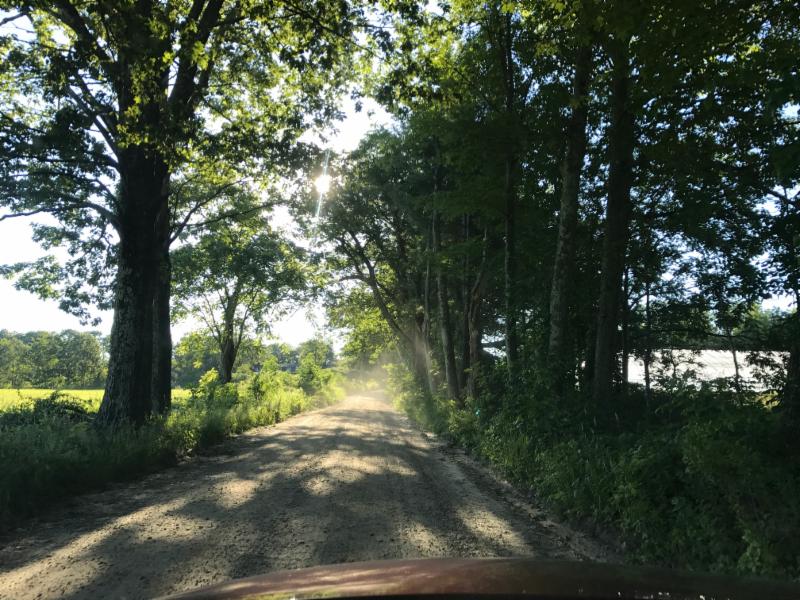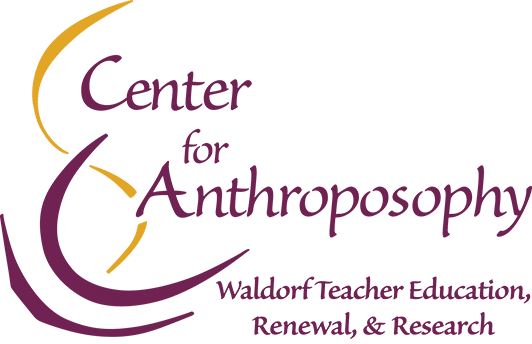 This summer, the Center for Anthroposophy, in conjunction with the Waldorf Program at Antioch University New England, completed a year-long self-study in preparation for renewal of membership in the Association of Waldorf Schools of North America (AWSNA). A sampling of sections from this study-addressing the “Big Question” of how to become a successful Waldorf teacher-is included in this issue, along with a whirlwind summary of other summertime activities and brief previews of things to come.
This summer, the Center for Anthroposophy, in conjunction with the Waldorf Program at Antioch University New England, completed a year-long self-study in preparation for renewal of membership in the Association of Waldorf Schools of North America (AWSNA). A sampling of sections from this study-addressing the “Big Question” of how to become a successful Waldorf teacher-is included in this issue, along with a whirlwind summary of other summertime activities and brief previews of things to come.
Best wishes for a productive fall season!
Douglas Gerwin, Director
Center for Anthroposophy
![]()
Dateline Wilton, NH: Summer Synopsis
Summer 2017 will be remembered for bursting enrollment, blistering heat, and several special visitors to the summer programs of the Center for Anthroposophy in Southern New Hampshire.
Each summer, the Center for Anthroposophy (CfA) offers five weeks of courses for perspective and practicing Waldorf teachers and those who support them in Waldorf schools. This year saw burgeoning enrollment for the two weeks of Renewal Courses, along with strong enrollment in the nine cohorts of teacher trainees – three for high school teachers sponsored by CfA plus six for elementary teacher trainees sponsored by the Waldorf Teacher Education Program at Antioch University New England (AUNE).
Renewal Courses
The growing popularity of so-called “grades-specific” courses boosted enrollment during the first week of Renewal Courses to more than 200 for the first time in the 18 years of this program. During the second week, a large turn-out for the course offered by Peter Selg and entitled “The Courage to Heal” brought enrollment to around 170 students (plus teaching faculty taking the total number over 400 for the fortnight). Karine Munk Finser, Coordinator of Renewal Courses, reports on plans for next summer separately in this issue.
Teacher Training Programs
A further 11 high school teachers graduated from CfA’s Waldorf High School Teacher Education Program, all of them already active in schools. Among the new and returning students in this program were high school teachers from as far away as Australia, Canada, China, Hungary, Korea, as well as all four corners of the North American continent — some 23 in all.
Among the six groups of Waldorf teachers in the Waldorf Program at Antioch University New England, three groups received their graduating stoles and certificates this summer, including a second cohort of Antioch’s “Advanced Track” for teachers specializing in pedagogy and the arts; this program is co-sponsored by Camphill, with guest faculty drawn from the leadership of the Camphill movement. In all, some 50 Antioch trainees graduated from their programs this July.
As in previous years, these groups endured a string of hot high-summer days, though an increasing number of classrooms now benefit from newly installed units of air conditioning.
AWSNA Visiting Committee
During the final week of this summer program, CfA hosted a three-person Visiting Committee as part of CfA’s renewal of membership in the Association of Waldorf Schools of North America (AWSNA). Ken Smith, Director of the Bay Area Center for Waldorf Teacher Training, led the team, which also included Frances Vig from the Chicago Waldorf School and Peter Lehman from the Kimberton Waldorf School.
The team was able to extend its visit to include the final evening of artistic presentations by the nine teacher training groups as well as the conjoint CfA-AUNE commencement exercises the following morning on the last day of the program.
The report of the Visiting Committee will be taken up this fall by AWSNA’s Teacher Education Network and Accreditation and Review Committee.
![]()
Dateline Wilton/Keene NH: What It Take to Become a Waldorf Teacher
As part of renewing its membership in the Association of Waldorf Schools of North America (AWSNA), the Center for Anthroposophy, along with the Waldorf Teacher Education Program at Antioch University New England, undertook a year-long review of its programs and guiding mission. Below we offer the opening and closing sections of this study, focusing on the essential elements of becoming a successful Waldorf teacher.
From the Foreword: “On Becoming a Waldorf Teacher”
Becoming a Waldorf teacher requires a willingness to learn–and so to teach–in an entirely new way.
Rather than teaching students simply to learn familiar answers, a Waldorf educator teaches them to ask unfamiliar questions.
Instead of teaching from concepts to experiences or examples of these concepts–for instance, from a rule of grammar to examples of that rule, or from a principle of physics to evidence of this principle in the lab–the Waldorf educator teaches the other way around: from experience to concept. Sometimes this approach is called the “discovery method” or a “phenomena-based education”. This approach to teaching may take longer, but its results last a lifetime.
To become a Waldorf teacher requires inner work and self-transformation.
To be able to change children, one must first be able to change oneself. Charity begins at home.
To become a Waldorf teacher requires a willingness to work with colleagues on an equal footing and to take responsibility for the school as a whole.
Most Waldorf schools are led by their own teachers or those mandated by them to administer the school.
To become a Waldorf teacher requires trust and patience.
Trust bestows confidence that a child will grow through foreseeable stages of development (some of them turbulent); patience bestows wisdom to guide the child through these stages.
To become a Waldorf teacher requires an ability not only to teach through the arts but to teach artistically.
This means each lesson is not only beautifully crafted but is authentic. Most Waldorf classes are conducted without reference to a textbook, though students read widely in primary sources.
To become a Waldorf teacher requires a warm sense of humor.
Nuff said.
To become a Waldorf teacher requires special training.
First comes Foundation Studies in Anthroposophy and the Arts; then comes early childhood, elementary, or high school Waldorf teacher education including an extended internship or practicum. Finally, there are ongoing Waldorf refresher courses.
And how did Rudolf Steiner himself answer this question? In his closing remarks to the original circle of 12 teachers who inaugurated the first Waldorf school in Stuttgart, Steiner articulated four conditions to becoming a Waldorf teacher:
A Waldorf teacher must be a person of initiative.
A Waldorf teacher must be interested in every facet of life.
A Waldorf teacher must never compromise with untruth.
A Waldorf teacher must always be fresh, never sour.
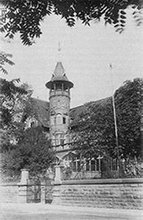
II From the Afterword: “Key Questions for the Art of Teaching”
You know only what you love —
And the deeper the knowledge is to be,
The more passionate must be the love.
— Johann Wolfgang von Goethe
What does it take to become a successful teacher?
James Ryan, Dean of Harvard’s Graduate School of Education, recently offered some simple yet telling responses to this lingering question. In commencement remarks both lighthearted and poignant, he singled out a few questions of his own that, he said–like keys on a chain–can open doors to lasting success as a teacher. To his surprise, his remarks went viral on the Internet, attracting more than eight million hits.
The first of Dean Ryan’s key-in-lock questions–“Wait, what?”–is the retort he gets whenever he asks his indignant children to clean their room. “Wait, whaat?” they wail. In the home setting, this exclamation typically represents a juvenile tactic to stall or deflect an unpleasant task.
The same question, however, when blurted out by a student during an exchange with a thought-provoking teacher, may prompt the student to slow down, to re-examine unchallenged assumptions, to think afresh. “Wait . . . WHAT??”: it’s a question that lights up inner worlds — as well as the classroom, too.
Another key question, the Dean suggests, is “How can I help . . . ?” When emphasis is placed on the first word, “How“, this offer becomes a variation of the fundamental social question, or what in Waldorf circles would be called the “Parzival question”.
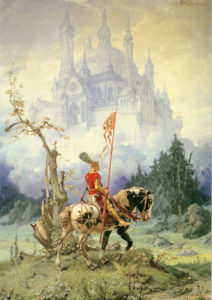
This question bestows upon the educator–as on the future Grail king–a mood of humility and of not knowing, of allowing teacher to be directed by student, rather than the other way around. We recall how, in at least one version of the legend, Parzival finds his way to the Castle of Munsalvaesche only after he throws the reins over the head of his steed, allowing the horse–not the rider–to find the path.
In the end, though, the most important question a teacher needs to ask is: “What truly matters . . .?” This question, according to Dr. Ryan, gets at the heart of successful teaching, since it points to the essential relationship that must obtain between teacher and student if there is to be significant learning.
And the terms of this relationship, he asks? That the student feels beloved.
This response–surprising to hear, perhaps, from a leading spokesman for an established academic institution–closely echoes the question that Rudolf Steiner regularly posed of the children at the first Waldorf school in Stuttgart.
“And do you love your teachers?” he would ask at school assemblies. The children, if official records of these events are to be trusted, would roar in response, “Ja!”
As the founder of Waldorf education, Rudolf Steiner voiced this question repeatedly because he knew that, ultimately, children learn from their teachers in a healthy way only if they love their teachers. And by the same token, children learn only if they feel beloved–“cherished, respected,” in Dr. Ryan’s words–by those entrusted to lead them along the road of their self-chosen destiny.
“Feeling beloved” should not be confused with “being liked”, especially in the age of Facebook and the Internet. Rudolf Steiner is speaking here about the exercise of an archetypal form of wisdom, not a personal form of affection, because students feel most beloved when they are seen for who they truly are (or are striving to become).
“We must imbue all our teaching with a feeling that standing before us is a growing human being, one who continues what took place in the supersensible world before conception and birth,” is how Steiner puts it. “This feeling must permeate us completely. Only when we are truly permeated by this feeling can we teach properly.”
Deeply enhanced insight is required, therefore, if the teacher is to see through the scrim curtain of a child’s sense perceptible countenance into a much wider stage of pre-earthly existence or into the far-expanding spaces of an uncharted future.
We call our children, rightly, “the Future”: future mothers and fathers; future writers, musicians, doctors; future pilots, teachers, eurythmists; future politicians, philosophers, plumbers; future citizens of a complex world. And yet for a teacher to gauge an individual child’s future–like trying to anticipate fluctuations in the mood of a classroom–is a task beyond the range of quotidian senses.
To common-day sensory eyesight, our budding scholars appear weary in one moment, yet in the next they are enthusiastic; now they are full of cheer, later they are peevish; this morning they are transparent, by the afternoon inscrutable; they laud us, then make us feel like fools. Where shall we find the wisdom to guide and educate this “Future”? How does a teacher develop those supersensory organs of cognition needed to glimpse–beyond the momentary flickering moods of soul–a student’s steady eternal flame?
“Every human being is a teacher, but he is sleeping and must be awakened,” says Steiner. “Art is the awakener . . . . When this is developed it brings the teacher, as a human being, nearer to those whom he would educate.”
Through the arts–more precisely, through the tempests and torments, Goethe’s Sturm und Drang, of artistic creation–we develop slowly, arduously those organs of supersensory knowing (otherwise called intuitive capacities) by means of which we may perceive what our students yearn to receive from us. Then we begin to hear, as on the wings of an angel, a student’s faint yet distinct response to the question, “How can I help. . . ?”
More than from any store of knowledge or intelligence or skill or techniques of classroom management, the regular practice of artistic creation–a discipline that permeates any successful Waldorf teacher training–will develop in teachers the capacities to see deeply into the souls of their students, to discern who they were even before they approached this earth, and to intuit what, in that light, they bring both as gifts and as needs for their latest journey. With this kind of training, we come to see “what truly matters,” a phrase now transformed from question to insight.
The purpose of art is to lay bare the questions
which have been hidden by the answers.— James Baldwin, The Creative Process
![]()
Dateline Freeport ME: New Line-Up of Foundation Studies Clusters
Barbara Richardson, Coordinator of CfA’s Foundation Studies in Anthroposophy and the Arts, reports on the line-up of clusters for this coming year.
A new round of clusters–some spread over two years but others compressed into a single school year–are starting up this fall and into the winter. Details of times, dates, and levels of tuition are available for each cluster on the website.
Here is the line-up for this year:
Year One
Buffalo, NY – at the Aurora Waldorf School
Chapel Hill, NC – at the Emerson Waldorf School
Freeport, ME – at the Maine Coast Waldorf School
Santa Fe, NM – at the Santa Fe Waldorf School
Year One & Two
Chicago, IL — at the Urban Prairie Waldorf School
Year Two
Carbondale, CO – at the Waldorf School on the Roaring Fork
Santa Fe, NM – at the Santa Fe Waldorf School
Tucson, AZ – at the Tucson Waldorf School
Interest being shown in:
Asheville, NC –
Baltimore, MD –
Bethesda, MD –
Beverly, MA –
Hadley, MA –
Contact Barbara Richardson at brichardson@centerforanthroposophy.org
for details and developments.
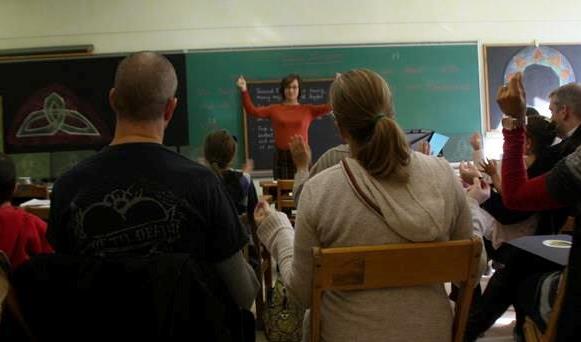
![]()
Dateline Wilton NH: Renewal Courses Reviewed – and Previewed
Karine Munk Finser, Coordinator of CfA’s popular Renewal Courses, looks back on a sumptous summer – and offers a peek into the next one.
Dear Friends,
There were plenty of meaningful memories from Renewal 2017, and I would like to thank all of you who shared the special celebratory weeks: both faculty and participants made those summer days full of life and learning, full of encounters, and there were also moments of fun for all. Over 400 participants and faculty gathered on the pretty green hill of High Mowing and Pine Hill school in Wilton, New Hampshire, during two weeks of 5- day courses with faculty from near and far.
The first week of grade-specific courses was filled to the brim, and David Gable sang delightfully with us all every morning and shared music with every grade as well. Roberto Trostli taught the science classes to the upper elementary grades and offered an unforgettable keynote on the opening night. Cezary Ciaglo, who has been with us since the beginning 18 years ago, taught eurythmy. Peter Sheen brought games and Spacial Dynamics.
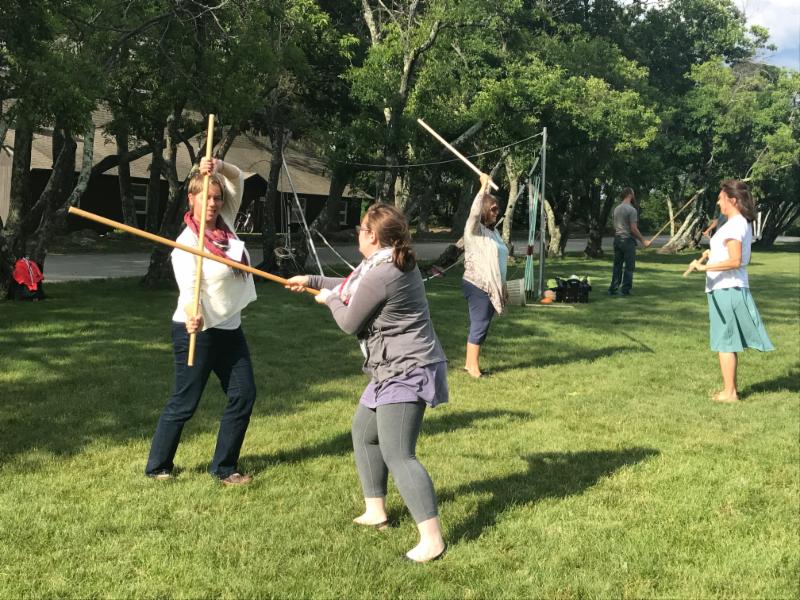
A stellar faculty taught grades 1-8 and Christof Wiechert offered his second year of supporting facilitators in the Child Study, so needed in our schools. In addition to teaching his own course, Christof gave daily lectures to all the participants of the first week, a hugely popular daily morning event! ( Grades faculty 2017: Regine Shemroske, Rob Lanier, Christopher Sblendorio, Neal Kennerk, Patrice Maynard, Lynn Thurrell, Alison Henry, and Signe Motter) Michael Howard shared an evening on form and metamorphosis and left us a beautiful exhibit of contemplative work. Musicians led by Andrew Koutroubas brought us a profound musical experience.
New this year was an evening where the faculty led small groups of discussions focusing on important themes that the participants chose. This Colloquium was popular and next year we hope to lengthen this evening event. To make time to talk to one another is an essential part of our Renewal encounter: we want to know what you carry as challenges in your schools and classrooms. The week ended with a celebratory swing dance led by Jan Lade, our Norwegian jazz trumpeter and his joyful musicians.

In 2018, we would like teachers who are taking the first week of courses to feel encouraged to stay for a second week and will offer them 50% scholarship towards a course in the second week.
The second week was devoted to Renewal courses that are close to our mission: life-long learning to deepen soul capacities through anthroposophical study. In the course on the Courage to Heal, Peter Selg brought a sacramental approach to lecturing, which was transformative for all in the lecture hall. Chris Bamford led us to the big “Yes” of unconditional hospitality, of an active life participating gesture of selflessness. Lucky were the people in the poetry course with Patrice Pinette who worked with the living word and inner transformation through the doorway of the 12 senses. Mary Stuart Adams brought a thought provoking keynote, played with stars, stories, and constellations while Sandy Pearson, with Glynn Graham visiting, safely made dolls for children to play with, and a group of sewing and happy people brought their own form of cosmos to the earth.
Enormous preparatory work on conflict in our workplaces was taking place with John Cunningham and Barbara Richardson, while Gotthart Killian brought a group of music enthusiasts guidance and insight into music and a schooling path and together with pianist Marcus Macauley, offered a moving concert that included original poetry.
We will never forget Jeff Spade and his group of delightful singers and conducters-in-training, how they surprised us with an impromptu demonstration that brought tears to our eyes. Every morning Jeff held our entire group of Renewal participants in song…and in joy. Linda Bergh was a wonder bringing Life Cycles and hands-on work with biographical studies while Michael D’Aleo brought Living Thinking in a way that truly challenged old patterns of thinking. Finally, Chuck Andrade led his artists in the laws of light and darkness, in movement and form, and in color, creating veilpaintings.
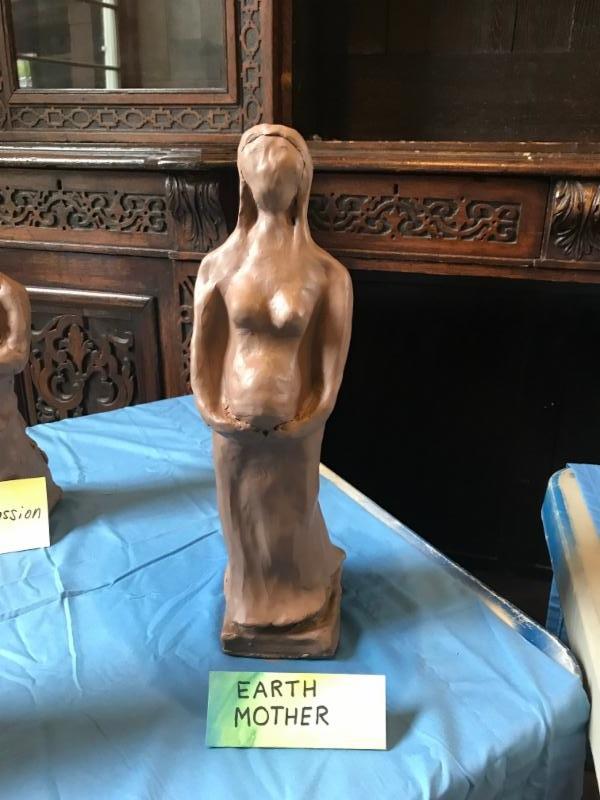
Elizabeth Auer, a master in many arts, chose to work in clay accompanying
Gotthart and Linda to great enhancement of several themes from the classes. Peter was active in movement and Cezary enriched with eurythmy.
We were most fortunate to have Glen Williamson bring several Kurt Vonnegut pieces to a “laughing out loud” large crowd. Contrasting this was Peter’s evening lecture on the Foundation Stone Meditation, a very profound event that bound the audience together in close community. Patrice shared a Poetry Reading and moved everyone with her words while an accompanying harpist brought Celtic music that wove between the spoken words.
So these were memories of a beautiful Renewal 2017-but what does Renewal 2018 look like?
Much is already being prepared: there will be some new grade specific teachers that will join some who have been with us for a while. Christof Wiechert has announced that he will teach two more years: please join us practicing the joy and courage in teaching Christof brings in his unique way, and come practice facilitating the Child Study which is at the heart of the faculty meeting.
In the second week we are planning a course that addresses teaching mixed grades: Grades 1 and 2, grades 3 and 4. We will also offer a mixed grade 5 and 6, 7 and 8. We are planning to bring a course on special education and will announce the faculty very soon. Jamie York will return with Projective Geometry. We will welcome the author and teacher Karsten Massei who will offer a course on Elemental Beings, accompanied by Jonathan Greene who will offer a daily workshop in creating a little nature-being for classroom or home. Michael D’Aleo is returning and we are planning to offer a course on Death, Destiny, and Threshold Experiences. Please visit this website, which we will update as courses and faculty are confirmed.
Dates for Renewal 2018
Week 1: June 24th to June 29th
Week 2: July 1st to July 6th
I want to wish you a continued good fall and best wishes on all your endeavors!
Karine

![]()
Dateline Wilton NH: A Score and More of Graduates
CfA’s Waldorf High School Teacher Education Program (WHiSTEP) is about to graduate its 21st group of high school teachers. Douglas Gerwin, founder of this program, briefly previews the forthcoming cycle.
The next round of the Waldorf High School Teacher Education Program (WHiSTEP) – starting in July 2018 on the campus of High Mowing School, a Waldorf school in Wilton, New Hampshire – will mark its “coming of age” with the graduation of its 21st class of prospective and practicing high school teachers.
Launched in the summer of 1996, this three-summers course has graduated 182 high school teachers since its first class completed the program in 1998. At present over 120 current and graduated students are working in more than 50 Waldorf schools across North America – a few have even retired after two and more decades in the classroom.
As in previous years, next summer’s program will be offering specialization in:
- Arts/Art History – with Patrick Stolfo
- Biology and Earth Science – with Michael Holdrege
- English & Foreign Languages – with David Sloan
- History and Social Science – with Meg Gorman
- Mathematics and Computer Studies – with Jamie York
- Physics and Chemistry – with Michael D’Aleo
The schedule is arranged in such a way that students can specialize in either one or two of these areas.
The program also features hands-on seminars in “Living Thinking” with Michael D’Aleo, “Human Development and Waldorf High School Curriculum” with Douglas Gerwin, and “Professional Research” with Michael Holdrege, as well as workshops in drama (David Sloan), eurythmy (Laura Radefeld), music (Carol Kelly), sculpture (Patrick Stolfo), and other arts.
In addition to these three summer intensives, students undertake two years of independent studies including a research project and internship. Details of our forthcoming summer program–starting on Sunday 1 July and running until Saturday 28 July–can be viewed on this website.
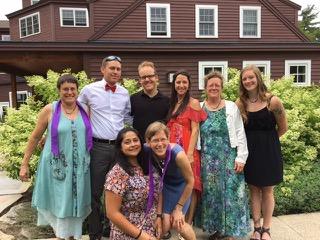
![]()
Dateline Wilton NH: Where Are They Now?
Of the 11 students who graduated this summer from CfA’s Waldorf High School Teacher Education Program (WHiSTEP), all have already been active in the classroom. Here is a brief outline of where they are working.
Of the Class of 2017, two-thirds were working in Waldorf schools even before they entered their training three summers ago in CfA’s Waldorf High School Teacher Education Program (WHiSTEP). They represent a full spread of North American addresses, from British Columbia and Southern California to “downeast” Maine and the East Coast Carolinas:
Wibke Fretz: teaching English, History, and German at the Portland Waldorf
School in Milwaukie, OR.
Nancy Goldberg: completed a year-round apprenticeship in English and Drama at Maine Coast Waldorf School in Freeport, ME.
Tyler Haughness: teaching math and outdoor education at the Shining Mountain Waldorf School in Boulder, CO.
Amy Kortus: teaching English and History at the Emerson Waldorf School in
Chapel Hill, NC.
Sara Purple McMullen-Laird: teaching arts and physics at various Waldorf
schools on the West Coast and now in Colorado.
Regina Samayoa-Barrios: teaching Spanish at Highland Hall Waldorf School
in Northridge, CA.
Meg Scherbatskoy: teaching at several small Waldorf schools in Vermont.
Emily Turner: teaching arts and life sciences at High Mowing School in
Wilton, NH.
Emma Wardrop: teaching English and History at the Whistler Waldorf School
in Whistler, BC.
Matt Witherow: teaching history and music at the Tara Performing Arts High
School in Boulder, CO.
Alex Workman: teaching life sciences at the Hartsbrook School in Hadley, MA.
Looking ahead to the summer of 2018, a new group of high school trainees is already forming, with specializations offered in
Arts and art history
- English language and literature
- History and social sciences
- Life science and earth science
- Mathematics and computer studies
- Physics and chemistry
For details, contact Douglas Gerwin, Director of the Center for Anthroposophy.
